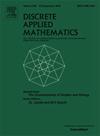Cluster Editing with Vertex Splitting
IF 1
3区 数学
Q3 MATHEMATICS, APPLIED
引用次数: 0
Abstract
Cluster Editing, also known as Correlation Clustering, is a well-studied graph modification problem. In this problem, one is given a graph and the task is to perform up to edge additions or deletions to transform it into a cluster graph, i.e., a graph consisting of a disjoint union of cliques. In this paper, we introduce a variation of Cluster Editing we call Cluster Editing with Vertex Splitting that extends this model to settings where clusters may be overlapping. Specifically, we allow a new edit operation that divides a vertex into two new vertices, each with a subset of the original neighbors. This approach addresses the limitations of assuming disjoint clusters, while still inherently limiting the amount of overlap when the number of edits is small. We show that Cluster Editing with Vertex Splitting is NP-complete and fixed-parameter tractable when parameterized by the number of editing operations . In particular, we obtain -time algorithm and a -vertex kernel.
聚类编辑与顶点分裂
聚类编辑,也被称为相关聚类,是一个被广泛研究的图修改问题。在这个问题中,给定一个图,任务是执行最多k个边的添加或删除,以将其转换为聚类图,即由不相交的团并组成的图。在本文中,我们引入了聚类编辑的一种变体,我们称之为顶点分割聚类编辑,它将该模型扩展到聚类可能重叠的设置。具体来说,我们允许一个新的编辑操作,将一个顶点分成两个新的顶点,每个顶点都有一个原始邻居的子集。这种方法解决了假设不相交集群的局限性,同时在编辑数量较小时仍然固有地限制了重叠的数量。我们证明了顶点分割的聚类编辑是np完全的,并且当用编辑操作的次数k作为参数时,是固定参数可处理的。特别是,我们得到了O(29klogk+n+m)时间算法和6k顶点核。
本文章由计算机程序翻译,如有差异,请以英文原文为准。
求助全文
约1分钟内获得全文
求助全文
来源期刊

Discrete Applied Mathematics
数学-应用数学
CiteScore
2.30
自引率
9.10%
发文量
422
审稿时长
4.5 months
期刊介绍:
The aim of Discrete Applied Mathematics is to bring together research papers in different areas of algorithmic and applicable discrete mathematics as well as applications of combinatorial mathematics to informatics and various areas of science and technology. Contributions presented to the journal can be research papers, short notes, surveys, and possibly research problems. The "Communications" section will be devoted to the fastest possible publication of recent research results that are checked and recommended for publication by a member of the Editorial Board. The journal will also publish a limited number of book announcements as well as proceedings of conferences. These proceedings will be fully refereed and adhere to the normal standards of the journal.
Potential authors are advised to view the journal and the open calls-for-papers of special issues before submitting their manuscripts. Only high-quality, original work that is within the scope of the journal or the targeted special issue will be considered.
 求助内容:
求助内容: 应助结果提醒方式:
应助结果提醒方式:


